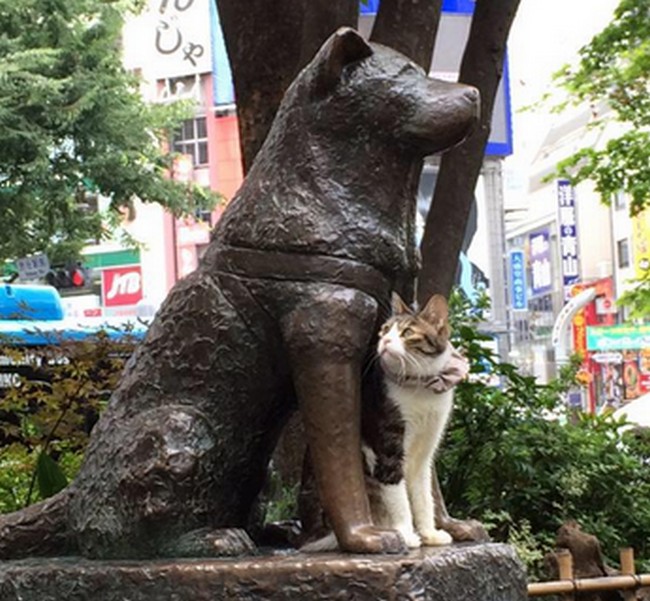Most people have probably heard of Hachikō because of the 2009 hit movie, Hachi: A Dog’s Tale. But the movie is only loosely based on his life and the real story really should be told.
What Kind of Dog Was Hachikō?
Hachikō was a golden-brown Akita Inu dog. The Akita Inu, or Akita, is a Japanese working breed the American Kennel Club describes as “Dignified, courageous and profoundly loyal to their humans”. Male Akitas like Hachikō grow to be 26-28 inches (66-71cm) tall, weigh 100-130 pounds (45-59kg), and live for about 10-13 years.

Who Was Hachikō’s Owner?
Hachikō was adopted by Tokyo University Professor Hidesaburō Ueno (Ueno-san) in 1924. During the week, Ueno-san commuted to work on the train from his home in Shibuya, Tokyo. Every day for over a year, Hachikō went to the train station to greet Ueno-san when he returned. Then the two would walk home together.
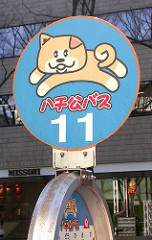
How Hachiko Became Famous
Hachikō was born on November 10, 1923 and started life as an ordinary family pet, but he quickly proved he was an extraordinary dog. Hachikō became famous throughout Japan for his steadfast loyalty and unwavering perseverance. After Ueno-san passed away from a brain hemorrhage in 1925, Hachikō continued to go to the train station every single day for almost 10 years (9 years, 9 months and 15 days to be exact) waiting for him to return. Ueno-san’s former student, Hirokichi Saito, followed the dog home one evening and learned Hachikō and Ueno-san’s story. After the details were printed in the Japanese newspaper Asahi Shimbun in 1932, people were so impressed with Hachikō’s love for his family that they began to bring him food and gifts to make his wait more comfortable. The story of Hachikō spread like wildfire throughout Japan and he became a symbol of loyalty and a source of national pride. In fact, the Japanese call Hachikō “Chūken Hachikō”, or, “Faithful dog Hachikō”.
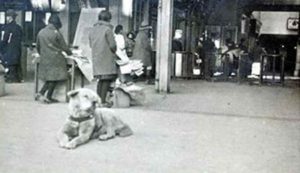
What Happened to Hachikō?
Hachikō passed away at the age of 11 on March 8, 1935 in Tokyo. Researchers discovered he died of cancer and a filaria infection (parasites like heartworms cause filarial infections). Hachikō is buried next to Ueno-san in Tokyo’s Aoyama Cemetery. While his death is certainly sad, Hachikō’s memory lives on. In addition to the movies about his life, Hachikō has four memorials that are visited by tens of thousands of people each year.
Where are the Memorials to Hachikō?
Hachikō has a beautiful statue right outside the Hachiko Exit of Tokyo’s Shibuya Station where he used to wait every day for Ueno-san (and Hachikō was even present for its unveiling in 1934!). He also has a large exhibit at the National Science Museum of Japan in Ueno, Tokyo, where his preserved fur is on display. In 2004, a third memorial was erected in Odate, Japan, where Hachikō was born, and the stone statue can be seen outside the Akita Dog Museum. The fourth memorial was erected on Tokyo University’s campus in 2015 and is a statue of both Ueno-san and Hachikō, showing them happily reunited. It’s how I like to imagine they are now. And if that’s not enough, there is even a kitty who regularly visits Hachikō’s statue!
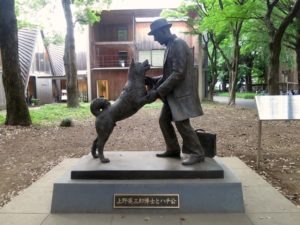
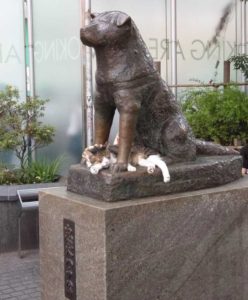
For detailed directions on how to get to the Hachikō Memorial in Shibuya, see How to Get to The Hachiko Memorial
For more stories on Japanese pets, check out Japan’s Fascination with Cats
Sources: American Kennel Club
![]()
Check Us Out!
- Facebook: @japanalytic
- Instagram: #japanalytic

